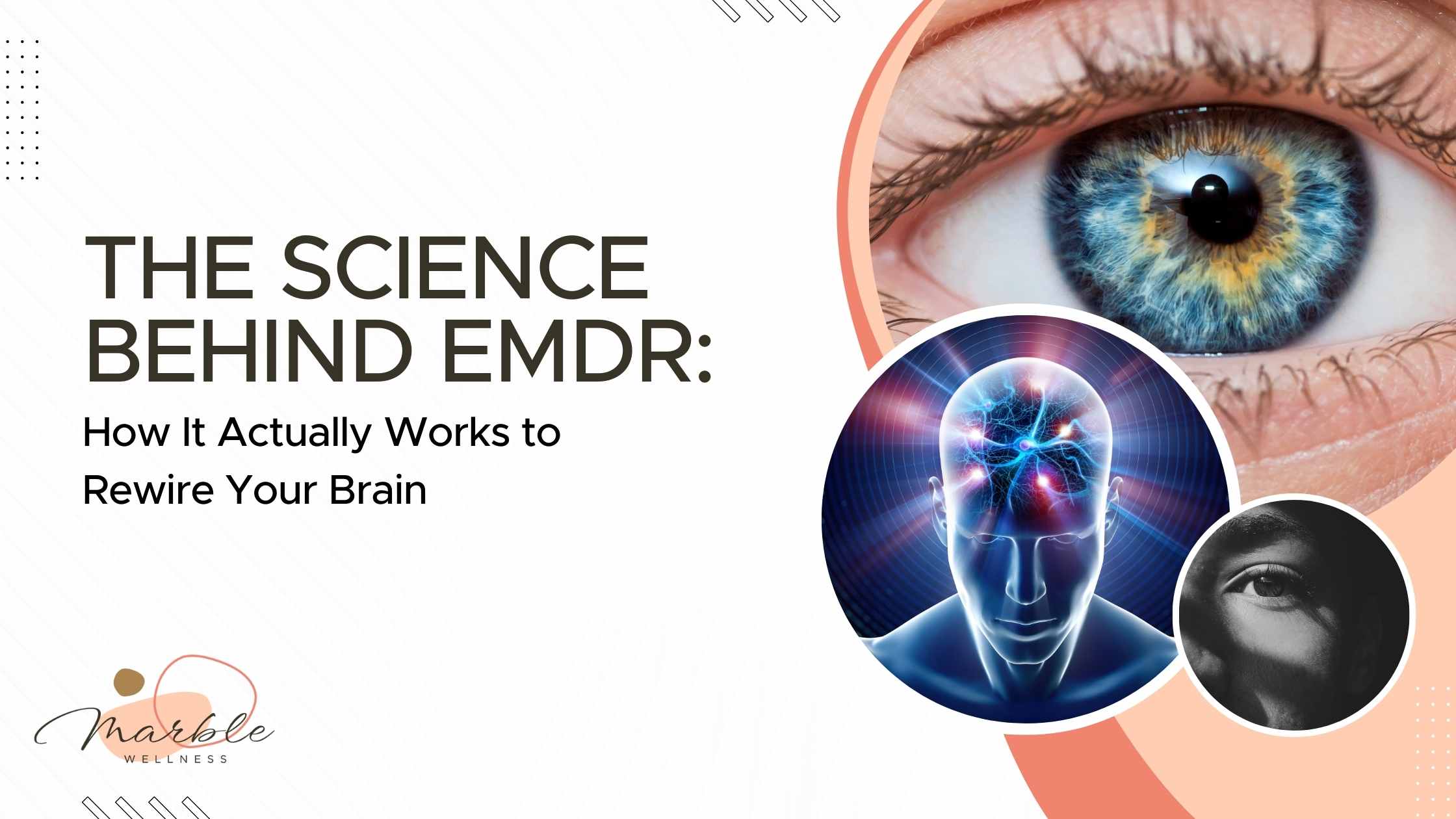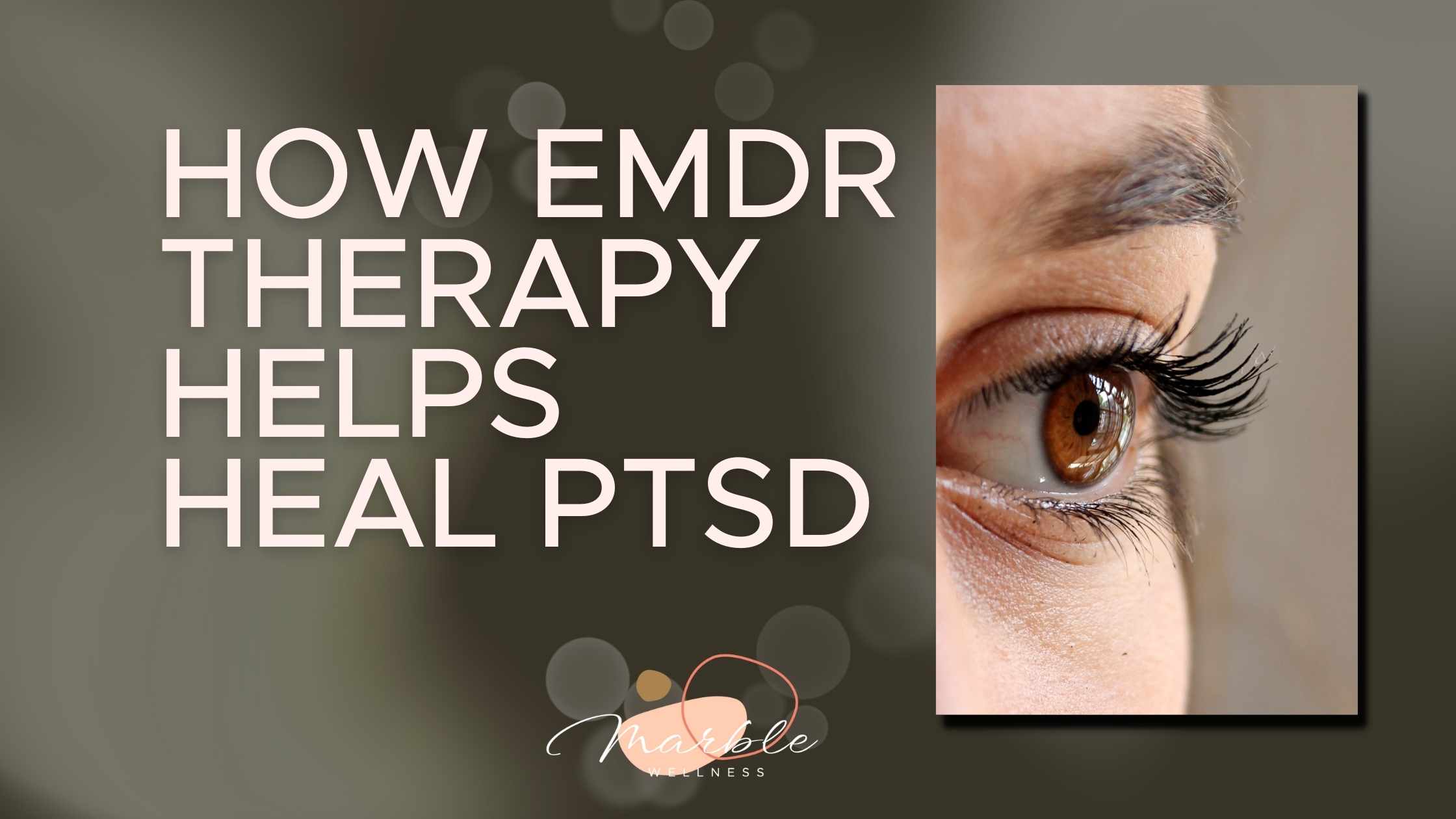Eye Movement Desensitization and Reprocessing (EMDR) therapy is a revolutionary approach to trauma healing. While many people have heard of EMDR, they may not fully understand what it is and how EMDR works to help heal trauma. EMDR’s success lies in its ability to tap into the brain’s natural healing processes, rewire neural pathways, and help people heal from trauma in a way that traditional talk therapy sometimes can’t.
In this post, we’re diving into the science behind EMDR—how it works, the brain mechanisms at play, and what makes it so effective in treating trauma. If you’ve ever been curious about how EMDR helps you reprocess difficult memories and what happens in your brain during this process, this blog will explain it all.
The Role of the Nervous System in Trauma
Trauma doesn’t just affect our minds; it also impacts our bodies. The nervous system, which is responsible for how we react to stress, can be deeply affected when we experience something traumatic. The body enters a state of heightened alertness—commonly known as the “fight, flight, or freeze” response. This reaction is meant to protect us in dangerous situations, but when the trauma is unresolved, our nervous system can stay “stuck” in this heightened state.
How Trauma Affects the Nervous System:
- Increased Anxiety: A constant state of alertness where the body is always prepared to “fight or flee.”
- Hypervigilance: Continually scanning your environment for danger, even when it’s not present.
- Numbing: Feeling emotionally detached or “numb” because of an overwhelming sense of stress.
EMDR helps by re-regulating the nervous system, calming it down through bilateral stimulation. This allows the nervous system to return to a balanced state, helping the body and mind heal from the trauma.
The Importance of Memory Processing in Healing
One of the ways trauma stays with us is through memories. When we experience something traumatic, the brain may not fully process it, leaving the memory “stuck.” Without resolution, traumatic memories can continue to intrude into our lives, affecting how we feel, think, and behave.
How Trauma Affects Memory:
- Fragmented Memories: Traumatic memories may not be fully processed, often feeling disconnected or incomplete.
- Intrusive Thoughts: Memories of the trauma may pop up unexpectedly, causing anxiety or distress.
- Stuck Emotions: Emotions tied to the trauma remain unresolved, often leading to a sense of emotional overwhelm.
EMDR helps by allowing the brain to reprocess and “refile” these memories, integrating them in a healthier, less distressing way. The traumatic memories are no longer overwhelming but are processed and stored more like any other memory.
How EMDR Facilitates Integration of the Past and Present
Trauma has a way of distorting our view of the world and ourselves. If left untreated, it can shape how we see the present. But EMDR doesn’t just help process the traumatic memories—it helps integrate those memories into the context of your whole life. This means that while the trauma is still a part of your past, it no longer defines your present or future.
How EMDR Helps with Integration:
- Connecting the Past to the Present: EMDR helps you reframe traumatic memories so they don’t control your current reality.
- Reinterpreting the Trauma: Instead of being defined by the trauma, you begin to see yourself as a survivor, not a victim.
- Reducing Emotional Intensity: The emotional charge tied to the memory is reduced, allowing you to think about the trauma without becoming overwhelmed.
Through this process, you’re able to integrate your past into your present, giving you control over your life and emotional state.
Why EMDR Is Different from Other Therapies
Traditional therapies like cognitive-behavioral therapy (CBT) focus on changing the way we think about things, which can be effective. However, EMDR goes beyond just thinking differently—it works on the brain’s physical and emotional systems. While other therapies focus primarily on talk and cognitive change, EMDR uses bilateral stimulation to activate both sides of the brain, facilitating a deeper, more holistic healing process.
How EMDR Differs from Other Therapies:
- Non-Talk-Based: Unlike talk therapy, EMDR uses bilateral stimulation to engage the brain’s natural healing mechanisms.
- Faster Processing: People often find that EMDR helps them process trauma more quickly and deeply than traditional methods.
- Body and Mind Integration: While talk therapy focuses primarily on cognitive processing, EMDR involves both the mind and the nervous system, providing a more comprehensive approach to healing.
EMDR’s holistic approach can help you move beyond the limits of traditional therapy, offering a faster and deeper resolution of trauma.
Scientific Evidence Supporting EMDR
There’s substantial scientific evidence backing EMDR as an effective treatment for trauma. It’s been researched extensively and has been found to significantly reduce PTSD symptoms and trauma-related distress. In fact, both the American Psychological Association (APA) and the World Health Organization (WHO) endorse EMDR as an evidence-based treatment for trauma and PTSD.
Research on EMDR:
- Numerous Studies: Research has consistently shown that EMDR can help reduce PTSD symptoms in a short period.
- Proven Effectiveness: Studies have demonstrated that EMDR is just as effective, if not more so, than other trauma-focused therapies, including CBT.
- Endorsement from Major Organizations: EMDR is officially recognized as a recommended treatment by both the APA and WHO.
The solid body of research supporting EMDR provides a strong foundation for its efficacy in trauma treatment.
What Does an EMDR Session Look Like?
Wondering what to expect during an EMDR session? While the process may feel a little different than other types of therapy, it is deeply transformative. During an EMDR session, your therapist will guide you through a traumatic memory while engaging in bilateral stimulation (such as eye movements or tapping). This allows the brain to process the trauma and reduce its emotional intensity.
What Happens During an EMDR Session:
- Revisiting the Memory: The therapist will help you identify a specific traumatic memory and the negative beliefs attached to it.
- Bilateral Stimulation: You will follow the therapist’s hand with your eyes or engage in tapping motions with your hands to stimulate both sides of the brain.
- Processing: As the memory is processed, the emotional charge around it begins to lessen, allowing you to feel more at peace with it.
Though it might seem unusual at first, many people experience profound relief and emotional release during and after their EMDR sessions.
EMDR’s Role in Long-Term Healing
What sets EMDR apart is that it offers lasting relief—not just symptom management. While traditional therapies may focus on managing the impact of trauma, EMDR targets the root causes and helps heal them. It doesn’t just alleviate symptoms temporarily; it helps your brain and nervous system process and release the trauma, making recovery last.
Long-Term Benefits of EMDR:
- Enduring Relief: After processing, the trauma no longer holds the same emotional weight, leading to lasting emotional stability.
- Better Emotional Regulation: Clients report better control over their emotions, with fewer instances of overwhelm or emotional outbursts.
- Healthier Relationships: As trauma is processed, many people experience improved communication and healthier connections with loved ones.
EMDR’s deep impact on the brain means that it helps clients heal in a way that lasts—allowing for permanent shifts in how they think, feel, and relate to others.
By delving into the science behind EMDR, we hope this blog has helped you understand how this innovative therapy works to rewire the brain and help heal trauma. Whether you’ve been considering EMDR for your own healing journey or you’re simply curious about how it works, understanding the science behind the therapy can give you a clearer picture of how it can help you move forward.
Start EMDR Therapy in Ballwin, MO, or Virtual EMDR in Missouri
If you live in the St. Louis metro area and are ready to improve your mental health, our expert St. Louis EMDR therapists are here to help. Get EMDR therapy in Ballwin, MO, or anywhere in the state via online therapy in Missouri! Reach out to our Client Care Coordinator today to discuss your EMDR therapy options.
Contact Us!
Learn About Our Group Offerings

Additional Counseling Services at Marble Wellness in St. Louis, MO
Marble Wellness Counseling services are designed to help set you on a path of living a more fulfilled, calm, and happy life. Our St. Louis area therapists have a variety of training backgrounds and areas of expertise. We specialize in anxiety, depression, grief, chronic illness, therapy for men, couples, and maternal overwhelm. Our practice also helps new moms with various postpartum concerns, moms in the thick of parenting, and moms with teens. We can also chat from wherever you are in the state with online therapy in Missouri. No matter where you are in your journey, we are here to help you thrive!



